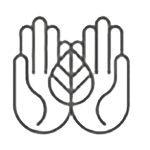Treatment methods of integrative medicine
Healing methods such as Chinese medicine, Japanese acupuncture or mitochondrial support are not a contradiction to conventional medicine, but a useful complement.
Learn more about the different treatment methods of integrative medicine:
Philosophy of Chinese medicine
Chinese medicine helps us to look at our illness from a completely new perspective because the philosophy is different. All the phenomena in the world are considered from the point of view of unity..
Chinese medicine – the unity of Yin and Yang:
 We often have difficulties perceiving the unity of Yin and Yang. Initially, we always tend to see two parts – day and night, hot and cold, man and woman. In the Chinese way of thinking, these two poles in our Western perception are not separate realities, they merely appear so. Day and night, for example, form an inseparable unity of 24 hours.
We often have difficulties perceiving the unity of Yin and Yang. Initially, we always tend to see two parts – day and night, hot and cold, man and woman. In the Chinese way of thinking, these two poles in our Western perception are not separate realities, they merely appear so. Day and night, for example, form an inseparable unity of 24 hours.
“When trying to understand complex matters, start with the simple, for mastering great things presupposes small beginnings.” (Laozi, De Dao Jing)
Chinese medicine, including acupuncture, Tuina, Qi Gong, pharmaceutical therapy and nutritional theory, tries to bring body and mind back into harmony, whilst incorporating all internal (such as emotions) and external factors (e.g. life circumstances, climatic and social environment).
“All illnesses are connected to the condition of the Qi.” (Huangdi Neijing c. 2600 BC)“
Japanese acupuncture
More than 1000 years ago, acupuncture was introduced into Japan by Buddhist monks and Japanese culture has left its own mark on acupuncture. The diagnosis is made by taking fine readings of the pulse and by palpating and feeling the abdomen (Hara diagnosis).
Comparison between Chinese and Japanese acupuncture
 One of special characteristics of Japanese acupuncture is the use of much finer needles than in Chinese acupuncture which are not inserted but merely come into contact with the skin’s surface.
One of special characteristics of Japanese acupuncture is the use of much finer needles than in Chinese acupuncture which are not inserted but merely come into contact with the skin’s surface.
This gentle method stimulates the acupuncture points, the meridians become more balanced and blockages disappear. Japanese acupuncture was traditionally practised by blind acupuncturists until the 19th century as sighted people need far more practice and experience to train their sense of touch.
A sensitive and experienced sense of touch is hugely important and central to Japanese acupuncture. The gentle treatment offered by Toyohari acupuncture focusses on the manner and method of touching.
Western healing methods
The classic Western natural healing methods include phytotherapy (use of medicinal plants as medicines), hydrotherapy and balneotherapy (water treatments, Kneipp), movement therapy, dietetics (nutritional therapy), aromatherapy and order therapy.
Western natural healing procedures – traditional, tried and tested
 “There is order in moderation; every bit too much and every bit too little causes sickness in the place of health.” Sebastian Kneipp
“There is order in moderation; every bit too much and every bit too little causes sickness in the place of health.” Sebastian Kneipp
Other naturopathic procedures include purging procedures (such as cupping, fasting, bloodletting, the application of leeches, Baunscheid therapy, compresses, drainage via the intestine and urine), neural therapy (influencing the vegetative nervous system through the application of a local anaesthetic), microbiological therapy (administration of microorganisms), autohaemotherapy and orthomolecular medicine (nutrient therapy).
My work as a doctor combines natural healing methods and conventional medicine on an equal basis.
Mitochondrial medicine
Mitochondria play a crucial role in the human body. The small cell organelles are often referred to as the power plants of our cells and can be found in each of our body’s cells.
Mitochondria – Power Plants of our Cells – Dysfunction and Treatment
 The energy released from metabolic processes is bound in ATP (adenosine triphosphate). Our mitochondria are primarily responsible for providing this energy – the ATP to the body’s cells. Life is not possible without ATP.
The energy released from metabolic processes is bound in ATP (adenosine triphosphate). Our mitochondria are primarily responsible for providing this energy – the ATP to the body’s cells. Life is not possible without ATP.
Mitochondrial diseases are characterised by a lack of energy, weakness and tiredness. Acquired dysfunctions of the mitochondria may be caused
- by environmental pollution and chemical exposure (heavy metals used in dental treatment etc.), mechanical trauma (e. g. in the cervical spine),
- chronic illnesses,
- oxidative stress (too many free radicals, detectable in special laboratories),
- severe psychological trauma or shock,
- serious and lasting mental and/or physical stress,
- medication (including antihypertensives, antibiotics, cholesterol and diabetes medication, sexual enhancers) and
- nitrate-rich nutrition.
There are numerous methods of treating mitochondrial diseases, ranging from purging procedures to specific dietary changes, intestinal treatment (including microbiological therapy), detoxification or enhancing detoxification functions of individual organs and even orthomolecular medicine.
The common goal of all these therapy procedures is the regeneration of damaged cells and cell organelles. One ancient principle of natural healing says “No healing without purification.”

